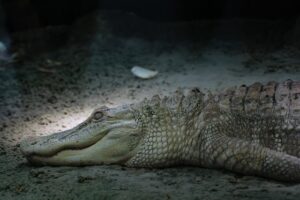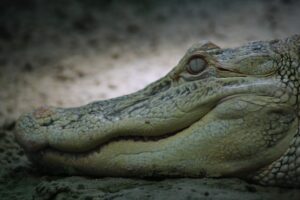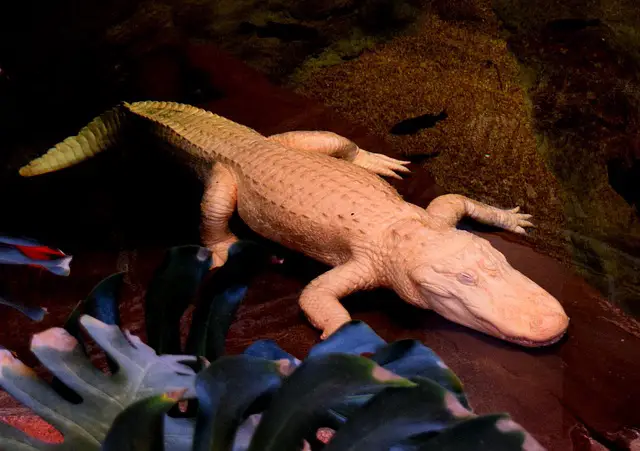Have you ever wondered what an albino alligator looks like? Albino alligators are a rare alligator species with white skin and pink eyes. They are often found in captivity but very rarely in the wild. To learn more about this unique species of alligator, let’s take a closer look at what an albino alligator looks like and other interesting facts about them.
What Do Albino Alligators Look Like?
Albinism in alligators is a rare genetic mutation, but when it does occur, the result is an albino alligator with incredible beauty.
People with albinism are characterized by an absence of melanin in their skin and eyes, leading to an alligator being completely white or ivory.
You may also find faint yellowish or golden pigmentation on the edges and in some areas of the body.
The most striking feature of albino alligators is the deep ruby-red eyes they possess, which stand out starkly against their ghostly white hide.
People with albinism pose no health risk compared to regular alligators, making them fascinating creatures to observe in captivity when allowed by law.

Where Are Albino Alligators Found?
While alligators are most commonly found in freshwater wetlands and swamps across the southeastern United States, albino alligators are much rarer.
They exist predominately within captivity or in managed wetland habitats and zoos.
Although sightings of albino alligators occur sporadically in nature along the Atlantic and Gulf coasts, from North Carolina to Texas, their pale coloration provides them with limited camouflage and makes them vulnerable predators; therefore, survival outside of these populations is not extremely common.
Therefore, although the white or partially white gators population is small compared to their normal-colored relatives, they can be found in specific areas that have purposely created environments for this unique species.
With proper care and management, we are seeing an albino alligator may no longer remain elusive.

What Is the Lifespan of an Albino Alligator?
Albinism is an uncommon condition in reptiles, occurring at a rate of roughly one in every 50,000. However, albino alligators are likely to have a slightly reduced lifespan due to their lack of natural camouflage and sensitivity to sunlight.
This can be countered by proper housing that provides ample shade and the best environmental sustenance possible.
With enthusiasts providing such conditions, there are reports of albino alligators surviving 20 years in captivity. As they do not reach maturity until around age 10-15, this leaves plenty of time for growth and perhaps even reproduction.
Conclusion:
While they may not live as long as regular American Alligators, Albino Alligators still make for fascinating creatures. Their white skin and pink eyes stand out from other species while blending into their environment thanks to elements such as white sand and oyster shells near the Suwannee River. Though it isn’t easy for them to survive in the wild due to their lack of camouflage from predators, these rare reptiles remain a remarkable sight when spotted.
FAQ’s
Q: Are albino alligators endangered?
A: No, although they are rare and their natural habitats are sometimes threatened, albino alligators are not considered endangered.
Q: How big do albino alligators get?
A: Albino Alligators typically grow to around 8-10 feet in length, which is the same size as a regular Alligator.
Q: Can albino alligators reproduce?
A: Yes, albino alligators can reproduce and have been known to do so successfully in captivity. However, their success in producing in the wild is unknown.
Q: What is the lifespan of an albino alligator?
A: Albinism is an uncommon condition in reptiles, occurring at a rate of roughly one in every 50,000. With proper care and management, there are reports of albino alligators surviving 20 years in captivity. As they do not reach maturity until around age 10-15, this leaves plenty of time for growth and perhaps even reproduction.
Conclusion:
Albino Alligators are a rare and remarkable sight to behold. Although harder for them to survive in the wild due to their lack of natural camouflage, these beautiful creatures can live up to 20 years in captivity with proper care and management. Although they are not considered endangered, their habitats should remain protected to ensure their future survival.




